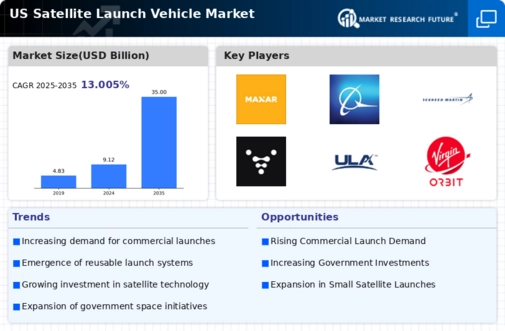Cost Efficiency in Launch Operations
The reusable satellite-launch-vehicle market is experiencing a notable shift towards cost efficiency, driven by the need to reduce launch expenses. Reusable vehicles can significantly lower the cost per launch, which is crucial for commercial operators and government agencies alike. For instance, the cost of launching a satellite can drop by as much as 30% when utilizing reusable technology. This financial incentive is compelling for both established aerospace companies and new entrants, as it allows for more frequent launches and broader access to space. As the reusable satellite-launch-vehicle market continues to mature, the emphasis on cost efficiency is likely to attract more investment and innovation, further enhancing the competitive landscape. The potential for reduced operational costs may also encourage more businesses to consider satellite deployment, thereby expanding the overall market size.
Growing Demand for Satellite Services
The demand for satellite services is on the rise, which is a significant driver for the reusable satellite-launch-vehicle market. With the increasing reliance on satellite technology for communication, navigation, and Earth observation, the need for frequent and reliable launches has become paramount. The market for satellite services is projected to grow at a CAGR of approximately 5% over the next five years, indicating a robust appetite for new satellite deployments. This growth is likely to spur investments in reusable launch systems, as they offer a viable solution to meet the escalating demand. As more companies and governments seek to leverage satellite capabilities, the reusable satellite-launch-vehicle market is positioned to play a critical role in facilitating this expansion, ensuring that launch services can keep pace with the burgeoning needs of various sectors.
Technological Innovations in Reusability
Technological innovations are a driving force in the reusable satellite-launch-vehicle market, as advancements in engineering and materials science enhance the capabilities of launch vehicles. Innovations such as improved propulsion systems, advanced avionics, and durable materials contribute to the reliability and reusability of launch systems. For example, recent developments in composite materials have led to lighter and more resilient structures, which can withstand the rigors of multiple launches. This focus on innovation not only improves performance but also reduces maintenance costs, making reusability more attractive. As technology continues to evolve, the reusable satellite-launch-vehicle market is likely to benefit from enhanced performance metrics, which could lead to increased adoption by commercial and governmental entities alike. The interplay between innovation and market demand may create a virtuous cycle, further propelling the industry forward.
Increased Investment in Space Exploration
The reusable satellite-launch-vehicle market is witnessing a surge in investment, particularly in the context of space exploration initiatives. Government agencies, such as NASA, and private companies are allocating substantial budgets to develop and enhance reusable launch systems. In 2025, it is estimated that investment in space exploration could reach upwards of $30 billion, with a significant portion directed towards reusable technologies. This influx of capital is likely to accelerate research and development efforts, fostering a more dynamic market environment. As funding increases, the potential for groundbreaking advancements in reusable launch systems becomes more pronounced, which may lead to new opportunities for collaboration and innovation. The focus on space exploration not only drives technological progress but also enhances the overall viability of the reusable satellite-launch-vehicle market.
Regulatory Support for Commercial Launches
Regulatory support is emerging as a crucial driver for the reusable satellite-launch-vehicle market, as government policies evolve to facilitate commercial space activities. The Federal Aviation Administration (FAA) and other regulatory bodies are streamlining the approval processes for launch operations, which is likely to encourage more companies to enter the market. By reducing bureaucratic hurdles, these regulatory changes can enhance the attractiveness of reusable launch systems, making it easier for businesses to plan and execute satellite launches. Furthermore, as regulations become more favorable, the market may see an influx of new players, increasing competition and innovation. This supportive regulatory environment is essential for the sustainable growth of the reusable satellite-launch-vehicle market, as it aligns with broader goals of expanding access to space and fostering economic development in the aerospace sector.






















Leave a Comment